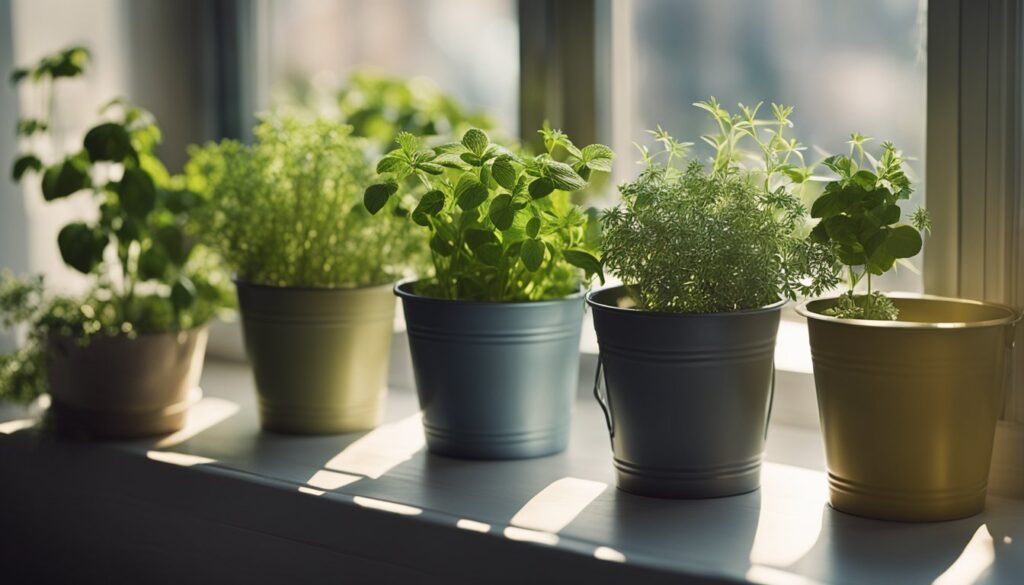Have you ever dreamed of growing your fresh herbs and vegetables but felt limited by space? Bucket gardening might just be the perfect solution for you. This innovative approach allows anyone, from urban dwellers to those with sprawling backyards, to cultivate a vibrant garden without the need for traditional plots. Using simple containers, you can create a lush oasis right on your balcony, patio, or even inside your home.
Imagine stepping outside and picking ripe tomatoes or fragrant basil just steps from your door. It’s not only a rewarding hobby but also a way to enjoy healthier meals and reduce grocery bills. Plus, bucket gardening is incredibly versatile and easy to customize to fit your lifestyle. Let’s dive into the world of bucket gardening and discover how you can transform your space into a thriving green sanctuary.
What Is Bucket Gardening?
Bucket gardening involves growing plants in containers, mainly buckets. This method suits those with limited space, like urban dwellers or anyone wanting a green touch at home. I can keep my mini garden on a balcony, patio, or even indoors.
Using buckets means I control the soil, drainage, and location. I can choose the plants that fit my taste and space. Imagine growing fresh herbs for my cooking or tomatoes for that perfect salad!
This technique makes gardening easy and enjoyable. It offers flexibility, so I can move my plants to get the best sun or shelter them from rain. Plus, buckets come in different sizes, making them perfect for veggies, herbs, or flowers alike.
Benefits of Bucket Gardening

Bucket gardening offers numerous advantages, making it fun and practical. I appreciate the ease of creating a productive garden without needing vast amounts of space.
Space Efficiency – Bucket Gardening: Herbs and Veggies in Small Spaces
Bucket gardening makes use of limited areas effectively. Small balconies transform into green oases. Indoor spaces can host vibrant plants on a sunny kitchen counter. Because buckets are portable, they can be moved as needed for sunlight or shade. This flexibility allows me to maximize the growth potential of each plant. A few buckets can yield a fresh supply of herbs and vegetables without the need for a full garden plot.
Accessible Gardening
Accessible gardening means everyone can join in, regardless of experience. I can start with simple herbs or go for advanced vegetables. Bucket gardening suits people with mobility issues. No kneeling or bending over to tend to plants reduces strain on the back and knees. Additionally, I can manage soil conditions more easily. By controlling the mix, I improve growth rates and plant health. This approach creates a welcoming opportunity for anyone to enjoy gardening, no matter their skill level.
Essential Supplies for Bucket Gardening
I gathered some must-have supplies for successful bucket gardening. These essentials help me create a thriving garden, whether on a balcony or indoors.
Choosing the Right Buckets – Bucket Gardening: Herbs and Veggies in Small Spaces
Selecting the right buckets makes a difference. I prefer using five-gallon buckets. They offer enough space for root growth. Ensure buckets have drainage holes. This prevents water from pooling and keeps plants healthy. Repurposed buckets work well, but I always clean them first. Colors like white or light shades reflect sunlight. This helps keep soil temperatures lower, especially on hot days. Don’t overlook size; I’ve found that larger buckets reduce the need for frequent watering.
Soil and Fertilizer Options
Soil choice impacts plant growth immensely. I use a mix of potting soil and compost for nutrients. This blend retains moisture while providing essential elements. Choosing organic fertilizers can boost plant health. My favorites include fish emulsion or seaweed extract. They give plants a healthy boost without chemicals. Make sure to mix fertilizers according to package instructions. Over-fertilizing can harm plants, and nobody likes a sad tomato plant. For regular maintenance, I apply fertilizer every few weeks during the growing season.
Vegetables and Herbs for Bucket Gardening
Growing vegetables and herbs in buckets is rewarding. It provides fresh flavors at my fingertips while saving money. Choosing the right crops makes a big difference in success.
Best Crops to Grow – Bucket Gardening: Herbs and Veggies in Small Spaces
For bucket gardens, certain crops thrive. I recommend these vegetables and herbs:
- Tomatoes: They love the sun and produce delicious fruit. Choose smaller varieties for buckets.
- Lettuce: Fast-growing and easy to maintain. I enjoy multiple harvests throughout the season.
- Radishes: They sprout quickly and add a spicy crunch. It’s fun to watch them grow.
- Basil: This fragrant herb grows well in buckets. It enhances dishes with its fresh taste.
- Peppers: These colorful plants add zest. They do well in limited space and bring vibrant colors.
Many other options exist, but starting with these can lead to a successful bucket garden.
Companion Planting in Buckets
Companion planting improves growth and deters pests. I mix different plants for better results. For example, basil and tomatoes grow well together. Basil enhances tomato flavor while keeping pests away.
Another great combo is lettuce and radishes. Radishes grow quickly, helping to shade the soil for slow-growing lettuce. This method not only boosts productivity but also maximizes bucket space.
Maintenance Tips for Successful Bucket Gardening
Bucket gardening thrives with proper maintenance. Keeping plants healthy and productive requires a few simple techniques.
Watering Techniques – Bucket Gardening: Herbs and Veggies in Small Spaces
Watering properly stands as one of the most crucial tasks. Check your buckets daily, especially in hot weather. I prefer to water in the morning to prevent evaporation and keep plants hydrated throughout the day. Target the soil directly, not the leaves. If the top inch feels dry, it’s time to water. Adding mulch on top helps retain moisture, too. Don’t drown your plants; soggy roots lead to trouble. Using a moisture meter can help me monitor wetness levels accurately.
Pest Management Strategies
Managing pests can be a challenge, but I’ve found some effective strategies. Inspect plants regularly for any signs of trouble. Look under leaves and near the soil; pests love hiding spots. Using a spray bottle filled with soapy water works wonders on common pests like aphids or spider mites. It’s safe and easy to make! If these pests invite themselves to my garden party, I simply spray them off.
Introducing beneficial insects, such as ladybugs, can also keep unwanted guests at bay. They munch on harmful pests like it’s an all-you-can-eat buffet. Keeping my garden clean and stylish helps too; remove any dead leaves or debris that might attract pests.
Before You Go – Bucket Gardening: Herbs and Veggies in Small Spaces

Bucket gardening has truly transformed the way I approach growing my food. It’s not just about saving money or having fresh herbs and veggies at my fingertips; it’s about the joy of nurturing plants and watching them thrive in a limited space.
With a little creativity and the right supplies, I can turn any corner of my home into a vibrant garden. The flexibility of moving buckets to catch the sun or shield plants from rain has made this method even more rewarding.
I encourage you to dive into bucket gardening and explore the possibilities. Whether you’re a seasoned gardener or a complete beginner you’ll find that this approach offers endless opportunities for growth and enjoyment. Happy gardening!
Don’t forget to add theherbprof.com homepage to your favourites so you don’t miss out on future articles.
References – Bucket Gardening: Herbs and Veggies in Small Spaces
Little Herb Encyclopedia, by Jack Ritchason; N.D., Woodland Publishing Incorporated, 1995
The Ultimate Healing System, Course Manual, Copyright 1985, Don Lepore
Planetary Herbology, Michael Tierra, C.A., N.D., Lotus Press, 1988
Handbook of Medicinal Herbs, by James A. Duke, Pub. CRP Second Edition 2007
The Complete Medicinal Herbal, by Penelope Ody, Published by Dorling Kindersley
Check the Following Articles
Hala Fruit: Discover Health Benefits and Recipes
Olive Leaf Extract: Relieve Sore Throat Naturally
Essential Oils for Nasal Dryness and Congestion Relief
Quinoa vs. Rice: Nutritional Differences and Health Benefits
Frequently Asked Questions – Bucket Gardening: Herbs and Veggies in Small Spaces
What is bucket gardening?
Bucket gardening is a method of growing plants in containers, primarily buckets. This technique is ideal for limited spaces, allowing individuals to cultivate fresh herbs and vegetables on balconies, patios, or indoors. It offers control over soil, drainage, and sunlight exposure.
What are the benefits of bucket gardening?
Bucket gardening allows for space-efficient plant growth, making it accessible for urban residents and anyone with limited gardening space. It provides flexibility in moving plants for optimal sunlight and protection, and it enables individuals to enjoy homegrown produce while reducing grocery costs.
What supplies do I need for bucket gardening?
To start bucket gardening, you’ll need suitable buckets (preferably five-gallon ones with drainage holes), quality potting soil, compost, and organic fertilizers like fish emulsion. Light-colored buckets can help reflect sunlight and manage soil temperature effectively.
Which plants are best for bucket gardening?
Ideal plants for bucket gardening include tomatoes, lettuce, radishes, basil, and peppers. These crops are generally easy to grow and flavorful. Companion planting, such as pairing basil with tomatoes, can also enhance growth and deter pests.
How often should I water my bucket garden?
Check buckets daily, particularly in hot weather. Water plants directly at the soil level, ensuring the soil stays moist but avoiding soggy roots. Using mulch and moisture meters can help retain soil moisture effectively.
How can I manage pests in my bucket garden?
Regularly inspect plants for pests and use soapy water sprays for common issues. Introducing beneficial insects, like ladybugs, can also help control harmful pests. These strategies contribute to maintaining a healthy and productive bucket garden.

